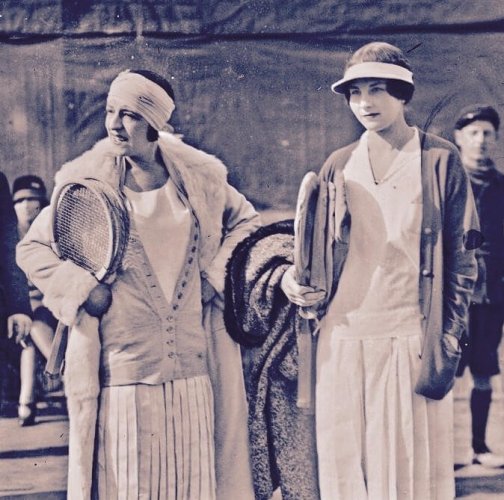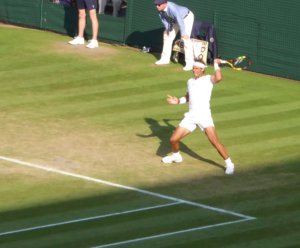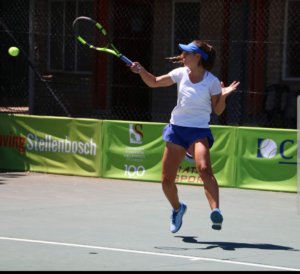(Originally published in the Israel Tennis Association website)
A short article published in the Hebrew newspaper “Doar Hayom” in February 1926, during the time of the British Mandate, reports on one of the world of sport’s most fascinating stories ever. It reads as follows:
“A Fabulous Victory for the Queen of Tennis”
“The final competition in the tennis match in Cannes (Southern France) raised great interest. The two competitors – Shoshana Lenglen (a Jew), also known as the “queen of tennis”, defeated Ms. Wills, a tennis hero in America. In the first set, Lenglen defeated Wills by six games to three, and in the second set by eight games to six.”
***
This somewhat ridiculous article, which names Suzanne Lenglen “Shoshana” and determined that she was a Jew, although there was no evidence as such, testifies to the immense interest raised by a single tennis match in 1926, between Lenglen and Wills. It was not even a Grand Slam tournament, or any other type of major tournament. According to various accounts, spectators at the competition numbered between 3,000 and 4,000. Ticket prices skyrocketed in the days before the match, and were sold on the day of the match by ticket scalpers at prices five or six times higher than starting prices, even though due to demand the tournament’s organizers had rushed to build additional seats in the stadium, and did not finish construction until immediately before the match began.
Enthusiastic spectators who couldn’t get tickets climbed up to the rooves of neighboring homes and even climbed a eucalyptus tree near the court. It was also reported that, during the match itself, angry French policemen tried to get children who had climbed up the eucalyptus down from the tree, and from time to time a child fell from the tree, disturbing the game. Celebrities and aristocrats were among the spectators, including the King of Sweden. The match was a main headline in all the papers, and journalist Ferdinand Tohee called it “the most important sporting event in the modern age, exclusively for the fairer sex.”
All that’s left: a fuzzy video segment from “the most important sporting event in the modern age”
So how did a single tennis match, in an insignificant tournament in Cannes, become such a sensation? It’s hard to answer that question, but even Wills, who wrote an article about the game seven whole years after it happened, claimed that “no tennis game deserves the attention accorded to this game […] I know that I, and apparently Mademoiselle Lenglen too, thought the significance of the match result was much greater than it really was. It’s not always easy to maintain a sense of proportion at a time like that”.
In February 1926, Helen Wills was a young American 19 year old who had begun to dominate the world of tennis. She first reached the US Open final at the ripe age of 16, but lost to the undefeatable tournament champion in those days, Molla Mallory. One year later, at the age of 17, she defeated Mallory in the final, a feat she repeated three times over the next three years. At 19, after winning three US Open championships and a gold medal in the 1924 Paris Olympics, she decided to travel to Europe again to play in a series of tournaments in the South of France. Her parents did not understand why she would want to do such a thing – weren’t the courts and players in California enough? Southern France was a meaningful choice, since Suzanne Lenglen, the best female tennis player in the world – and at that time the most important female tennis player in history – resided in Nice.
Lenglen, for whom the second most important stadium in the Roland Garros complex is named, was a true trailblazer. She conquered the hearts of spectators throughout the world with her French manners, and always played wearing a brightly colored headband which contrasted with the tennis whites worn by everyone else at that time. Writers commented that although she was not a particularly beautiful or wealthy woman, many high-society women paled next to her, due to her fanciful fashion sense and bold personality.
Lenglen was considered one of the first female star athletes in history, and the first real female star to come out of the world of tennis. The tournaments she played in during the 1920s were followed by masses. When France wanted to raise money to rehabilitate the devastated country after the First World War, it sent Lenglen to play in the United States, and even there she filled courts and ignited fans’ imaginations. In addition to her status as a star, Lenglen was, as mentioned above, the best tennis player in the world, by far. Although she did not win a huge number of Grand Slam tournaments (just eight), this was a result of circumstances not connected to Lenglen herself. For four whole years, the years of the First World War, tennis was not played throughout Europe. In addition, the French Open was a closed tournament for French players only until 1925, and her victories in the “World Hard Court Championships” in France (at that time clay courts were called “hard courts”) are not counted among her Grand Slam wins today.
Tennis historian Bud Collins wrote that when Lenglen heard that Wills was planning to play against her in the South of France, she said “that girl must be crazy. Does she think she can come and beat me on my home court?” That may have been one of the reasons the match was so exciting – the fact that Lenglen had almost never played in the United States and Wills did not visit Europe frequently transformed the battle between them, at a time when nationalism was gaining significant strength following the First World War, into a battle between peoples and nations. One might even think of the match as an American invasion on French shores.
There were major differences between the two in other respects. While Lenglen was colorful, exceptionally friendly, tended to mix with high society, and even played mixed doubles with the King of Sweden, Wills was shy and rarely socialized. The two were even different physically – Lenglen was slight and tended to play primarily defensive tennis or play the net, while Wills was a big and strong tennis player who liked to hit hard from the baseline. Charlie Chaplin wrote in his autobiography that the most beautiful sight he ever saw was the movement of Helen Wills playing tennis.
In the end, Lenglen was right. She won 6:3 8:6 (in those days there was no such thing as a tie breaker), but the different accounts of the game leave little room for doubt – the youthful Wills pushed the champion to the edge of her ability. After the game, Lenglen burst into tears. Dozens of photographers and journalists ambushed her while she was still on the court, and a battalion of tournament employees hurried onto the court with huge bouquets for the winner. Wills, shocked, remained alone on the court, all attention directed towards Lenglen, and slowly gathered her things together. One man approached her and reassured her, stating “you played great”. His name was Frederick Moody and he would later become her first husband.
A 19 Grand Slam Career. Helen Wills in Action.
Nobody knew this would be the last match between the two. Wills continued to play in Europe, but Lenglen avoided tournaments in which the American played, apparently at her father’s orders. The French Open should have served as the stage for another historic encounter between the two, but Wills withdrew from the tournament, as well as from Wimbledon and the US Open, due to appendicitis. At the end of 1926, Lenglen turned pro, while Wills remained in the amateur tour rotation, and the paths of the two never crossed again.
After Lenglen left the amateur tour, Wills positioned herself as one of the greatest female tennis players in history. In her career she won no less than 19 Grand Slam titles, including eight Wimbledon titles. Wills claimed that Lenglen showed her how to play tennis, and dramatically raised the bar for women’s tennis. Even after a long and fabulous career, Wills admitted that she went on to compare every game in her life with that match versus Lenglen. There, in an insignificant tournament in the South of France in 1926.



